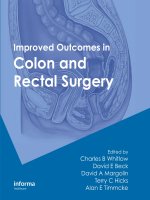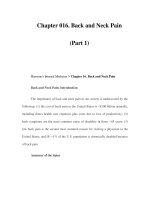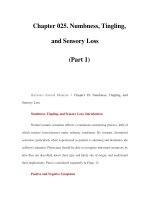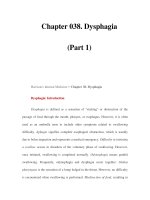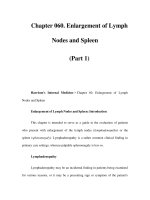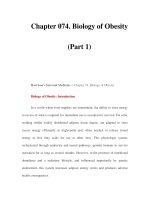Paediatrics & Child Health - part 1 ppsx
Bạn đang xem bản rút gọn của tài liệu. Xem và tải ngay bản đầy đủ của tài liệu tại đây (448.69 KB, 23 trang )
Paediatrics &
Child Health
Helen Brough
Rola Alkurdi
Ram Nataraja
Ajenthan Surendranathan
Editorial Advisors
Professor Brent Taylor
Dr Alastair Sutcliffe
Rapid
Paediatrics
and
Child Health
Brough / Rapid Paediatrics and Child Health Final Proof 8.7.2004 4:12am page i
Brough / Rapid Paediatrics and Child Health Final Proof 8.7.2004 4:12am page ii
RAPID
PAEDIATRICS
AND
CHILD HEALTH
Helen Brough
Rola Alkurdi
Ram Nataraja
All of
Royal Free and University College Medical School,
University College London, London
Ajenthan Surendranathan
St Bartholomew’s and the London Hospital, London
EDITORIAL ADVISORS
Brent Taylor
Professor of Community Child Health,
Royal Free and University College Medical School,
University College London, London
Alastair Sutcliffe
Senior Lecturer in Paediatrics
Royal Free and University College Medical School,
University College London, London
SERIES EDITOR
Amir H. Sam
Royal Free and University College Medical School,
University College London, London
Brough / Rapid Paediatrics and Child Health Final Proof 8.7.2004 4:12am page iii
# 2004 by Blackwell Publishing Ltd
Published by Blackwell Publishing Ltd
Blackwell Publishing, Inc., 350 Main Street, Malden,
Massachusetts 02148-5020, USA
Blackwell Publishing Ltd, 9600 Garsington Road, Oxford OX4 2DQ, UK
Blackwell Publishing Asia Pty Ltd, 550 Swanston Street, Carlton,
Victoria 3053, Australia
The right of the Authors to be identified as the Authors of this Work has
been asserted in accordance with the Copyright, Designs and Patents Act
1988.
All rights reserved. No part of this publication may be reproduced,
stored in a retrieval system, or transmitted, in any form or by any means,
electronic, mechanical, photocopying, recording or otherwise, except as
permitted by the UK Copyright, Designs and Patents Act 1988, without
the prior permission of the publisher.
First published 2004
Library of Congress Cataloging-in-Publication Data
Rapid paediatrics / Helen Brough [et al.].
p. ; cm. – (Rapid series)
Includes bibliographical references.
ISBN 1-4051-1642-0 (alk. paper)
1. Pediatrics–Handbooks, manuals, etc.
[DNLM: 1. Pediatrics–Handbooks. WS 39 R218 2004] I. Brough, Helen.
II. Series.
RJ48.R375 2004
618.92–dc22
2004002496
ISBN 1-4051-1642-0
A catalogue record for this title is available from the British Library
Set in Frutiger 7/9pt
by Kolam Information Services Pvt. Ltd, Pondicherry, India
Printed and bound in India by Replika Press Pvt. Ltd
Commissioning Editor: Vicki Noyes
Editorial Assistant: Nicola Ulyatt
Production Editor: Lorna Hind
Production Controller: Kate Charman
For further information on Blackwell Publishing, visit our website:
The publisher’s policy is to use permanent paper from mills that operate
a sustainable forestry policy, and which has been manufactured from
pulp processed using acid-free and elementary chlorine-free practices.
Furthermore, the publisher ensures that the text paper and cover board
used have met acceptable environmental accreditation standards.
Brough / Rapid Paediatrics and Child Health Final Proof 8.7.2004 4:12am page iv
Contents
Foreword, ix
Preface, xi
List of abbreviations, xiii
Rapid series mnemonic, xviii
Conditions, 1
Abnormal size at birth, 3
Acne vulgaris, 5
Acquired female genital disorders, 7
Anaemia, aplastic, 8
Anaemia, haemolytic, 9
Anaemia, iron deficiency, 11
Anaemia of prematurity, 12
Appendicitis, acute, 13
Asthma, 14
Atrial septal defect (ASD)/AVSD, 16
Attention deficit hyperactivity disorder (ADHD), 17
Autism, 18
Breath-holding attacks, 19
Bronchiolitis, acute, 20
Cerebral haemorrhage, 21
Cerebral palsy, 22
Child abuse, 24
Chronic lung disease (CLD) of prematurity, 26
Cleft palate disorder, 27
Coarctation of the aorta (COA), 28
Coeliac disease, 29
Congenital adrenal hyperplasia, 30
Congenital cytomegalovirus (CMV) infection, 31
Congenital hypothyroidism, 32
Congenital rubella infection, 33
Constipation, 34
Cow’s milk intolerance, 35
Cow’s milk protein allergy, 37
Croup (acute laryngotracheobronchitis), 38
Cryptorchidism, 39
Cystic fibrosis (CF), 40
Delayed puberty, 42
Depression, 44
Developmental dysplasia of the hip (DDH), 45
Diabetes mellitus (Type I) (DM), 46
Down syndrome (trisomy 21), 48
Duchenne/Becker muscular dystrophy, 49
Encephalitis, 51
Epiglottitis, acute, 52
Brough / Rapid Paediatrics and Child Health Final Proof 9.7.2004 11:59am page v
v
Epilepsy, 53
Exomphalos and gastroschisis, 55
Faecal soiling (encopresis), 56
Failure to thrive, 57
Febrile seizures, 58
Fractures, 59
Fragile-X syndrome, 60
Fungal skin infections, 61
Gastroenteritis, 63
Gastrointestinal (GI) atresia, 64
Gastro-oesophageal reflux disease (GORD), 66
Genetic skeletal dysplasias, 67
Global developmental delay, 68
Glomerulonephritis (GN), acute, 70
Group B streptococcal (GBS) infection, 71
Haemophilia, A and B, 72
Head lice (pediculosis), 73
Hearing impairment, 74
Heart failure, 76
Hernia, congenital diaphragmatic (CDH), 77
Hernias, inguinal and umbilical, 78
Herpes simplex, 79
Hirschsprung disease, 80
Human immunodeficiency virus (HIV), 81
Hydrocephalus, 82
Hyperthyroidism, 84
Hypoglycaemia in neonates, 85
Hypospadias, 86
Hypoxic–ischaemic encephalopathy (HIE), 87
Immunodeficiencies (inherited), 89
Impetigo, 90
Inadvertent poisoning, 91
Inborn errors of amino acid metabolism, 92
Inborn errors of carbohydrate metabolism, 94
Inflammatory bowel disease, 95
Intraventricular haemorrhage (IVH), 96
Intussusception, 97
Klinefelter syndrome, 98
Legg–Calve
´
–Perthes disease (LCPD), 99
Leukaemia, acute lymphoblastic (ALL), 100
Leukaemia, acute myeloblastic (AML), 102
Liver disease, chronic, 103
Liver failure, acute, 105
Lymphoma, Hodgkin’s, 106
Lymphoma, non-Hodgkin’s (NHL), 107
Malnutrition, 109
Malrotation of the intestine, 111
CONTENTS
Brough / Rapid Paediatrics and Child Health Final Proof 9.7.2004 11:59am page vi
vi
Marfan syndrome, 112
Measles, mumps, rubella (MMR), 113
Meckel’s diverticulum, 114
Meconium aspiration syndrome, 115
Meningitis, 116
Mesenteric adenitis, 118
Myotonic dystrophy, 119
Near-drowning, 120
Necrotising enterocolitis (NEC), 122
Neonatal jaundice, 123
Nephrotic syndrome, 125
Neuroblastoma, 127
Neurocutaneous syndromes, 128
Nocturnal enuresis, 130
Obesity in children, 132
Osgood–Schlatter disease, 134
Otitis media, acute and chronic secretory, 135
Patent ductus arteriosus (PDA), 136
Persistent pulmonary hypertension (PPH), 137
Pneumonia, 138
Pneumothorax, 140
Precocious puberty (complete), 141
Precocious puberty (partial), 142
Psoriasis, 143
Pulmonary stenosis, 144
Pyloric stenosis, 145
Recurrent abdominal pain, 146
Renal failure, acute (ARF), 147
Renal failure, chronic (CRF), 149
Respiratory distress syndrome (RDS), 151
Retinopathy of prematurity (ROP), 152
Rheumatic fever, 153
Scabies, 154
School refusal, 155
Septicaemia, 156
Short stature, 157
Sickle-cell anaemia, 159
Sleep-related disorders, 160
Slipped upper femoral epiphysis (SUFE), 161
Sticky eyes in the neonate, 162
Sudden infant death syndrome (SIDS), 163
Supraventricular tachycardia (SVT), 165
Testicular torsion, 166
Tetralogy of Fallot, 167
Thalassaemia, 169
Tics, 170
Toxoplasmosis (congenital), 171
CONTENTS
vii
Brough / Rapid Paediatrics and Child Health Final Proof 9.7.2004 11:59am page vii
Transient synovitis (TS)/Irritable hip, 172
Transient tachypnoea of the newborn (TTN), 173
Transposition of the great arteries (TGA), 174
Turner syndrome, 175
Upper respiratory tract infection (URTI), 176
Urinary tract anomalies, 177
Urinary tract infection (UTI), 178
Varicella (chickenpox), 180
Ventricular septal defect (VSD), 181
Visual impairment, 182
Whooping cough (pertussis), 184
Appendices, 185
Taking a history in paediatrics, 187
Neonatal resuscitation, 189
Formal assessment of the neonate at birth, 190
Examination of the newborn, 191
Breastfeeding vs. bottle-feeding, 194
Infant feeding, 196
Paediatric resuscitation, 198
Developmental stages in children, 199
Immunisation schedule, 202
Child health surveillance/promotion, 204
Status epilepticus, 205
viii
CONTENTS
Brough / Rapid Paediatrics and Child Health Final Proof 9.7.2004 11:59am page viii
Foreword
Rapid Paediatrics and Child Health has been written by a group of able
prize-winning clinical medical students from the Royal Free and University
College Medical School. They have developed a system that facilitates
understanding of paediatric conditions, most of them common and all of
those included, important. The authors have achieved an excellent synthe-
sis that should help in the care of individual children, while maintaining a
population and social perspective. This is a refreshing textbook that will
allow rapid and thorough review of paediatrics and child health.
London Brent Taylor
January 2004 Professor of Community Child Health
Alastair Sutcliffe
Senior Lecturer in Paediatrics
Brough / Rapid Paediatrics and Child Health Final Proof 8.7.2004 4:13am page ix
ix
Brough / Rapid Paediatrics and Child Health Final Proof 8.7.2004 4:13am page x
Preface
Rapid Paediatrics and Child Health is part of a series of books for medical
students that are designed to facilitate learning about core topics in a
structured format. Each page is divided into our own ‘surgical sieve’:
Definition, Aetiology, Association/Risk factors, Epidemiology, History,
Examination, Pathology/Pathophysiology, Investigations, Management,
Complications, and Prognosis. In this book we have included over 150
topics that cover major topics in all paediatric specialities and neonatol-
ogy. We have included core knowledge as well as up-to-date national
guidelines, important new investigative techniques, and treatment
options. The investigations mentioned are by no means carried out in all
children with a certain condition but only if they are deemed necessary.
This book has been designed to be easy to carry around and to allow rapid
access to information when in clinic or on wards so that you can consoli-
date theory with practice. We hope you enjoy reading this book as much
as we have enjoyed writing it!
Our editorial advisors Professor Brent Taylor and Dr Alastair Sutcliffe have
been a fantastic support and we are very grateful for the hours they have
put in to making this book possible. We would also like to thank Dr Giles
Kendall, who kindly reviewed our neonatal topics.
London Helen Brough
January 2004 Rola Alkurdi
Ram Nataraja
Ajenthan Surendranathan
Brough / Rapid Paediatrics and Child Health Final Proof 8.7.2004 4:13am page xi
xi
Brough / Rapid Paediatrics and Child Health Final Proof 8.7.2004 4:13am page xii
List of abbreviations
ABC airway, breathing,
circulation
ABG arterial blood gases
ABVD adriamycin, bleomycin,
vinblastine, and
dacarbazine
ACTH adrenocorticotrophic
hormone
AD autosomal dominant
ADHD attention deficit
hyperactivity disorder
AFP alpha fetoprotein
AIDS acquired
immunodeficiency
syndrome
ALL acute lymphoblastic
leukaemia
ALP alkaline phosphatase
ALT alanine aminotransferase
ALTE apparent life-threatening
event
AML acute myeloblastic
leukaemia
AN anorexia nervosa
AP anteroposterior
APTT activated partial
thromboplastin time
AR aortic regurgitation
AR autosomal recessive
ARDS acute respiratory distress
syndrome
ARF acute renal failure
ASA aminosalicylic acid
ASD atrial septal defect
ASOT anti-streptolysin O titre
AST aspartate
aminotransferase
ATG antithymocyte globulin
ATN acute tubular necrosis
ATP adenosine tripho sphate
AV atrioventricular
AVPU alert, verbal response,
painful response,
unresponsive
AVSD atrioventricular septal
defect
AXR abdominal X-ray
b.d. twice a day
BCG bacille Calmette–Gue
´
rin
BiPAP bilevel positive airways
pressure
BM blood monitor/monitoring
BMD Becker muscular dystrophy
BMI body mass index
BMJ British Medical Journal
BMT bone marrow transplant/
transplantation
BP blood pressure
BPD bronchopulmonary
dysplasia
bpm beat per minute
BTS British Thoracic Society
CAD coronary artery disease
cAMP cyclic adenosine
monophosphatase
CBT cognitive–behavioural
therapy
CCDC consultant in
communicable disease
control
CD Crohn’s disease
CDH congenital diaphragmatic
hernia
CF cystic fibrosis
CFTR cystic fibrosis
transmembrane regulator
CGG cytosine-guanine-guanine
CHB complete heart block
CHD congenital heart disease
CHF congestive heart failure
CLD chronic lung disease
CMV cytomegalovirus
CNS central nervous system
COA coarctation of the aorta
CPAP continuous positive
airways pressure
CPK creatinine phosphokinase
CRF chronic renal failure
CRHD chronic rheumatic heart
disease
CRP C-reactive protein
CSF cerebrospinal fluid
CT computerised tomography
CTG cardiotocography/graph
CVP central venou s pressure
CVS chorionic villous sampling
CXR chest X-ray/radiograph
DD differential diagnosis
DDH developmental dysplasia
of the hip
DDT dichlorodiphenyltri-
chloroethane
Brough / Rapid Paediatrics and Child Health Final Proof 8.7.2004 4:18am page xiii
xiii
List of abbreviations
DEXA dual-energy X-ray
absorptiometry
DIC disseminated
intravascular
coagulation/
coagulopathy
DIP distal intraphalangeal
DISIDA diisopropyl
iminodiacetic acid
DKA diabetic ketoacidosis
DM diabetes mellitus
DMD Duchenne muscular
dystrophy
DMPK dystrophia myotonica
protein kinase
DMSA dimercapt osuccinic
acid
DNA deoxyribonucleic acid
DNAse deoxyribonuclease
DPT diphtheria, pertussis,
tetanus
DSM-IV Diagnostic and
Statistical Manual of
Mental Disorders,
4th edition
DTPA diethylenetriamine
pentaacetic acid
DVT deep vein thrombosis
EBV Epstein–Barr virus
ECG electrocardiogram/
graph
ECMO extracorporeal
membrane
oxygenation
EEG electroencephalogram
ELISA enzyme-linked
immunosorbent assay
EMG electromyogram/
graph
ENT ear nose throat
EPO erythropoietin
ERCP endoscopic retrograde
cholangiopan-
creatography
ESR erythrocyte
sedimentation rate
ET endotracheal
FVIII–FXI factor VIII to factor XI
FAB French–American–
British
FAS foetal alcohol
syndrome
FBC full blood count
FEV forced expiratory
volume
FFP fresh frozen plasma
FGFR3 fibroblast growth
factor receptor 3
FH father’s height (cm)
FMR1 fragile-X mental
retardation 1
FMRP fragile-X mental
retardation protein
FSH
follicle-stimulating
hormone
G6PD glucos e-6-phosphate
dehydrogenase
GBS group B streptococcus
GCS graduated compression
stockings
GFR glomerular filtration
rate
GH growth hormone
GI gastrointestinal
GN glomerulonephritis
GnRH gonadotrophin-
releasing hormone
GOR gastro-oesophageal
reflux
GORD gastro-oesophageal
reflux disease
GP general practitioner
GSD glycogen storage
disease
GTCS generalised tonic-clonic
seizures
GU genitourinary
GVHD graft-versus-host
disease
HA haemophilia A
HAV Hepatitis A virus
Hb haemoglobin
HB haemophilia B
HBV hepatitis B virus
HC haemophilia C
HCG human chorionic
gonadotrophin
HCV hepatitis C virus
HDL high-density
lipoprotein
HFO high frequency
oscillation
Hib Haemophilus
influenzae b
LIST OF ABBREVIATIONS
Brough / Rapid Paediatrics and Child Health Final Proof 8.7.2004 4:18am page xiv
xiv
List of abbreviations
HIDA hepatobiliary
iminodiacetic acid
HIE hypoxic–ischaemic
encephalopathy
His histidine
HIV human
immunodeficiency virus
HLA human lymphocyte
antigen
HR heart rate
HS hereditary spherocytosis
HSP Henoch–Scho
¨
nlein
purpura
HSV herpes simplex virus
HTLV human T-lymphotropic
virus
HUS haemolytic uraemic
syndrome
IBS irritable bowel syndrome
ICP intracranial pressure
ICS inhaled corticosteroids
ICSI intracytoplasmic sperm
injection
ICU intensive care unit
Ig immunoglobulin
IGFBP-3 insulin-like growth
factor–binding protein 3
IHD ischaemic heart disease
INR international
normalised ratio
IM intramuscular
IP intraphalangeal
IUGR intrauterine growth
restriction/retardation
IV intravenous
IVH intraventricular
haemorrhage
IVU intravenous urogram
JVP jugular venous pulse
LABA long-acting b
2
-agonist
LCPD Legg–Calve
´
–Perthes
disease
LDH lactate dehydrogenase
LFT liver function test
LGA large for gestational age
LH luteinising hormone
LHRH luteinising-hormone-
releasing hormone
LIF left iliac fossa
LP lumbar puncture
LRTI lower respiratory tract
infection
LVF left ventricular function
LVH left ventricular
hypertrophy
MAG3 mercaptoacetyltri-
glycine
MALT mucosa-associated
lymphoid tissue
MCH mean cell/corpuscular
haemoglobin
MC+S microscopy culture +
sensitivity
MCUG micturating
cystourethrogram
MCV mean cell/corpuscular
volume
MDD major depress ive
disorder
Men C meningitis C
MH mother’s height (cm)
MMR measles, mumps, rubella
MR mitral regurgitation
MRI magnetic resonance
imaging
MSE mental state
examination
MSU midstream specimen of
urine
MVP mitral valve prolapse
NA noradrenaline
NAI nonaccidental injury
NBM nucleus basalis
magnocellularis
NEC necrotising enterocolitis
NEJM New England Journal of
Medicine
NF neurofibromatosis
NG nasogastric
NHL non-Hodgkin’s
lymphoma
NICE National Institute
for Consumer
Education
NICU neonatal intensive care
unit
NK natural killer
NO
nitric oxide
NSAID nonsteroidal anti-
inflammatory drug
NSPCC National Society for the
Prevention of Cruelty to
Children
OCA oculocutaneous albinism
LIST OF ABBREVIATIONS
Brough / Rapid Paediatrics and Child Health Final Proof 8.7.2004 4:18am page xv
xv
List of abbreviations
OCD obsessive–compulsive
disorder
OCP oral contraceptive pill
OGD oesophagogastroduo-
denoscopy
OPV oral polio vaccine
ORT oral rehydration therapy
OTC over-the-counter
PA pulmonary artery
PAS periodic acid–Schiff
PCP Pneumocystis carinii
pneumonia
PCR polymerase chain
reaction
PDA patent ductus arteriosus
PE pulmonary embolism
PEN pharmacy equivalent
name
PET positron emission
tomography
PICU paediatric intensive care
unit
PKU phenylketonuria
PNH paroxysmal nocturnal
haemoglobinuria
p.o. per os
POS polycystic ovary
syndrome
PPH persistent pulmonary
hypertension
PPV positive pressure
ventilation
PROM prolonged rupture of
membranes
PSC primary sclerosing
cholangitis
PTH parathyroid hormone
PTSD post-traumatic stress
disorder
PUVA psoralen ultraviolet A
q.d.s. four times a day
RAH right atrial hypertrophy
RBC red blood cell/count
RDS respiratory distress
syndrome
REAL revised European and
American lymphoma
REM rapid eye movement
Rh rhesus
rhGH recombinant human
growth hormone
RIF right iliac fossa
RNA ribonucleic acid
ROM range of movement
ROP retinopathy of
prematurity
RSV respiratory syncitial
virus
RTA road traffic accident
RVH right ventricular
hypertrophy
RVT renal vein thrombosis
SBP systolic blood pressure
SC subcutaneous
SCBU Special Care Baby Unit
SCID severe combined
immunodeficiency
S/E side-effects
SGA small for gestational age
SIADH syndrome of
inappropriate
antidiuretic hormone
SIDS sudden infant death
syndrome
SIgAD selective immunoglobulin
A deficiency
SIRS systemic inflammatory
response syndrome
SLE systemic lupus
erythematosus
SMA superior mesenteric
artery
SOB shortness of breath
SPAG small particle aerosol
generation
SSPE subacute sclerosing
panencephalitis
SSRI selective serotonin
reuptake inhibitor
STD sexually transmitted
disease
SUDEP sudden unexpected death
in epileptic patients
SUFE slipped upper femoral
epiphysis
SVC superior vena cava
SVT supraventricular
tachycardia
SW southwest
T
3
tri-iodothyronine
T
4
thyroxine
TB tuberculosis
t.d.s. three times a day
TFT thyroid function test
LIST OF ABBREVIATIONS
Brough / Rapid Paediatrics and Child Health Final Proof 8.7.2004 4:18am page xvi
xvi
List of abbreviations
TGA transposition of the
great arteries
THAM tris(hydroxymethyl)-
aminomethane
TLC total lung capacity
TOF tracheo-oesophageal
fistula
TOP termination of
pregnancy
TORCH toxoplasma, other
(syphilis, HIV), rubella,
cytomegalovirus,
hepatitis
TPN total parenteral
nutrition
TRH thyrotropin-releasing
hormone
TS transient synovitis
TS1&2 tuberous sclerosis 1&2
TSH thyroid-stimulating
hormone
TSI thyroid-stimulating
immunoglobulin
TSS toxic shock syndrome
TTN transient tachypnoea
of the newborn
TTP thrombotic
thrombocytopenic
purpura
U&E urea and electrolytes
UC ulcerative colitis
UDPGA uridine
diphosphoglucuronic
acid
UKALL United Kingdom
Medical Research
Council protocol for
childhood ALL
URT upper respiratory
tract
URTI upper respiratory tract
infection
USS ultrasound scan
UTI urinary tract
infection
UTR untranslated region
UV ultraviolet
VACTERL vertebral, anal, cardiac,
tracheal, esophageal,
renal, limb
VE varicella embryopathy
VF ventricular fibrillator
VON varicella of the
newborn
VSD ventricular septal
defect
VT ventricular tachycardia
VUR vesicoureteric reflux
VZV varicella zoster virus
WCC white cell count
WHO World Health
Organization
WPW Wolff–Parkinson–
White (syndrome)
XLA X-linked
agammaglobulinaemia
F female
M
male
18 primary
28 secondary
" increase(d)
# decrease(d)
! to/lead(s) to
> greater than
< less than
$ approximately
 times
LIST OF ABBREVIATIONS
Brough / Rapid Paediatrics and Child Health Final Proof 8.7.2004 4:18am page xvii
xvii
Rapid series mnemonic
D: Definition Doctors
A: Aetiology Are
A/R: Associations/Risk factors Always
E: Epidemiology Emphasising
H: History History-taking &
E: Examination Examining
P: Pathology Patients
I: Investigations In
M: Management Managing
C: Complications Clinical
P: Prognosis Problems
Brough / Rapid Paediatrics and Child Health Final Proof 8.7.2004 4:18am page xviii
xviii
CONDITIONS
Brough / Rapid Paediatrics and Child Health Final Proof 9.7.2004 2:44pm page 1
Brough / Rapid Paediatrics and Child Health Final Proof 9.7.2004 2:44pm page 2
Abnormal size at birth
D: SGA: birth weight < 20th percentile for gestational age or < 2.5 kg.
LGA: birth weight > 90th percentile for gestational age or > 4 kg.
A: SGA: may be familial, constitutional, or due to IUGR.
IUGR is defined as either symmetrical or asymmetrical:
Asymmetrical IUGR: relative sparing of head circumference in relation to
weight and length:
. Due to impaired uteroplacental function 28 to maternal pre-eclampsia, DM
or nutritional deficiency during the 3rd trimester.
. Occurs when foetal growth rate in 3rd trimester exceeds maximal supply
from the placenta.
. There is preferential sparing of the cerebral perfusion at times of foetal
distress.
Symmetrical IUGR: head circumference, weight, and length are all propor-
tionally affected to equivalent degrees:
. Indicative of a prolonged period of poor intrauterine growth.
. Caused by congenital intrauterine infections (TORCH) in the 1st trimester,
genetic factors such as single gene deletions and chromosomal disorders,
maternal smoking, drug and alcohol abuse, chronic medical conditions (e.g.
CRF), malnutrition, or multiple pregnancies.
LGA: macrosomia is a feature of infants of mothers with either gestational or
poorly controlled/undiagnosed DM.
A/R: IUGR: previous SGA infant, low pre-pregnancy weight and poor pregnancy
weight gain.
E: SGA: affects by definition 20% of the population and varies with ethnic back-
ground.
IUGR: 2/200 neonates; asymmetrical > symmetrical IUGR.
LGA: affects by definition 20% of live births; is more common in developed
countries where there is a higher prevalence of DM.
H&
E:
Antenatal: maternal examination and accurate dating aid diagnosis. Oligo-
hydramnios and poor foetal movements are indications of placental insuffi-
ciency.
Perinatal monitoring: foetal tachycardia, loss of variability of the baseline in
the foetal heart trace, and late decelerations may indicate foetal distress on
CTG.
Postnatal measurements: birth weight, length, and head circumference on
centile chart.
P: See A.
I: Radiology: USS is the 18 method of diagnosing IUGR or macrosomia ante-
natally.
Cordocentesis: percutaneous umbilical blood sampling may be used for de-
tection of hypoxia, lactic acidosis, hypoglycaemia, chromosomal analysis, and
DNA diagnosis of congenital intrauterine infections.
M: Antenatal: maternal bedrest and limitation of activity for severe IUGR.
Perinatal: maternal administration of O
2
, continuous assessment of foetal
well-being.
Delivery (IUGR): if foetus becomes hypoxic in utero, an emergency
Caesarean section is required.
Macrosomia: induce at 38/40 to prevent complications in a unit with good
neonatal facilities.
3
CONDITIONS
Brough / Rapid Paediatrics and Child Health Final Proof 9.7.2004 2:44pm page 3
Abnormal size at birth continued
C: IUGR foetus: intrauterine hypoxia, birth asphyxia, and death.
IUGR infant: hypothermia (relatively large surface area), hypoglycaemia
(poor fat and glycogen stores), hypocalcaemia, polycythaemia, and meconium
aspiration.
LGA: birth asphyxia due to prolonged/difficult delivery, birth trauma, espe-
cially shoulder dystocia, hypoglycaemia in the neonatal period due to hyper-
insulinism, and polycythaemia.
P: Depends on the cause of abnormal size at birth. Infants with asymmetrical
IUGR will rapidly put on weight in the postnatal period; symmetrical IUGR
infants are more likely to remain small permanently. Studies have shown that
IUGR infants are at "risk of developing "BP, Type II DM, and coronary heart
disease.
4
CONDITIONS
Brough / Rapid Paediatrics and Child Health Final Proof 9.7.2004 2:44pm page 4
